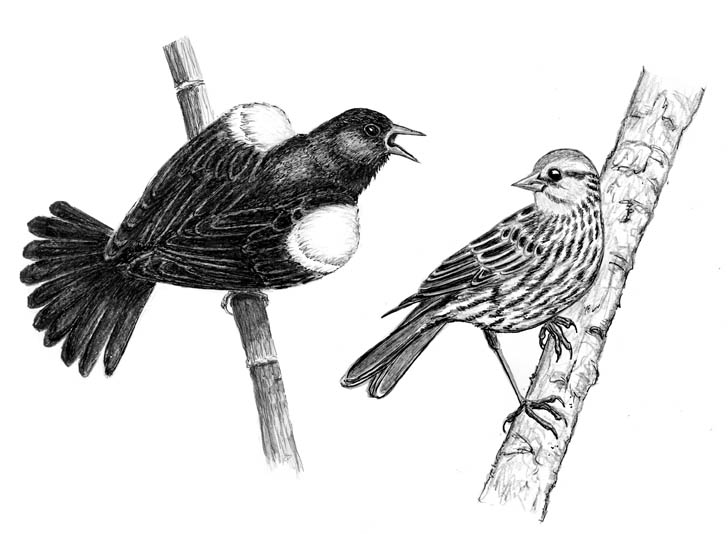
Dear Bird Folks,
Could you please tell me what bird this is? See attached photo.) It looks a bit like a sparrow, but it’s way bigger than the other sparrows on my feeder.
– Sarah, Marion, MA
It’s a Red-winged Blackbird, Sarah,
I would love to tell you that your mystery bird is some kind of rare giant sparrow, or at least string you along for awhile before finally coming clean with the truth, but not this time. This is one of the most common bird ID questions I get, yet no one is ever happy with my answer. People insist their bird couldn’t possibly be a Red-winged Blackbird, as it’s not black and doesn’t have red wings. That’s when I have to pull out the books and show them. For some reason, they believe the books over me. (Probably a wise choice.)
They say that “opposites attract,” but I’m not sure if the old adage is actually true. Many birds, such as Blue Jay and catbird couples, aren’t opposite; they look totally the same, and they get along just fine. My wife and I aren’t opposite either. We agree on just about everything…except for perhaps one, or two or ten gazillion things, or more. But other than that…
Other bird couples may not look the same, but it’s pretty obvious that they are a pair. For example, a female cardinal doesn’t look like the male, but we all know she’s a cardinal. This is not the case with Red-winged Blackbirds. The two sexes could not look any more dissimilar. The male is jet black all over. His feathers are black, his feet and legs are black, and his eyes and even his beak are black. His only non-black coloring is the red (with some yellow) on his signature wing patches. Meanwhile, his mate looks like she’s not even the same species, or even from the same zip code. She is streaky brown, with conspicuous light “eyebrows,” faint pink on her wings, and a splash of peach on her throat. This non-black, blackbird is the bird in your photo. It’s just that simple. Well, not really.
To make things more confusing, it takes a while for the young male blackbirds to turn black. For the first few months of their lives they too are streaky brown and look a bit like their mothers, but not quite. Eventually, the males will become black and get their famous red wing patches. These patches should clear everything up, right? Once again, not really. Even the wing patches can cause some confusion (to us, not the birds). The male Red-winged Blackbird has the ability to flash the brilliant red whenever he wants to make his presence known, especially on the breeding grounds. His red patches are ideal for showing off, but they’re also a liability when it comes to hiding from predators. Not to worry. The bird has it figured out. When a male Red-winged Blackbird would rather not be noticed, he simply keeps the red patch hidden under his black feathers. Now he’s totally black, except for a thin line on each wing. The thin line gives him a bit of style, like a John Waters moustache. Seeing a red-wing without red wings can once again cause some folks to think they have a new bird in their yard, and once again I have to dig out the bird books. (Am I the only one who still uses books?)
Why are the females so dull, you ask? It is generally thought their brown coloring helps to keep them hidden, especially while they’re incubating eggs. This makes sense, I guess, but don’t try telling that to Mrs. Blue Jay. She’s as bright blue as her old man. Where’s her camouflage, she wants to know? (Perhaps nature realizes that even predators don’t like to deal with jays.)
The fact that red-wings are sexually dimorphic (the sexes don’t look the same) might be confusing to us, Sarah, but it is clearly working for them. With an estimated population of 150 million individuals, Red-winged Blackbirds are one of the most abundant birds in North America. It’s just too bad nobody knows what the female looks like. Apparently, her camouflage is working too well, or maybe she just needs a better agent.
While we are on the topic of strange birds:
Mid-summer is primetime for oddballs. For instance, right now we are seeing cardinals with brown bills, instead of the usual red. The brown bills belong to the newbies, at least for a few more weeks, when their beaks will also turn red. Male Brown-headed Cowbirds are gray when they first fledge, but eventually their bodies will become glossy black. As the birds transition, however, they are covered in weird patches of both black and gray, looking like a shedding buffalo. One of our most common birds is the European Starling. Even non-birders know what this glossy/speckled bird looks like. But right now young starlings are drab gray, kind of catbird-ish. This gray plumage will last until September, when their bodies will gain their adult speckles. Although, their heads will remain gray for a few more weeks, just to mess us up.
This last oddity doesn’t happen to all birds, but when it does happen it really freaks people out. Occasionally a bird (often a jay or cardinal) will molt all of its head feathers at once. The bird is essentially bald and rather creepy looking. The reasons for this instant head-molt aren’t clear, but ultimately the feathers will grow back and the bird will be normal once again. Until then, offering a small hat and extra-strength sunblock are all we can do to help.